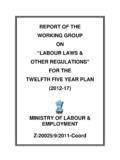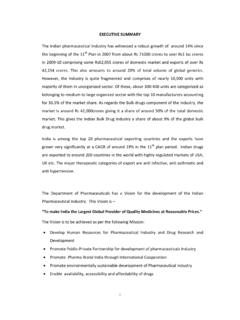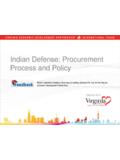Transcription of Bidding Process for the Delhi and Mumbai Airports
1 Case Study 26/08/2010 1 Planning Commission (Secretariat for Infrastructure) Bidding Process for the Delhi and Mumbai Airports Prateek Kuhad August 2010 This case study should not be reported as representing the views of the Planning Commission. The views expressed in this case study are those of the author and do not necessarily represent the views of the Planning Commission. This study is being published as part of a larger effort in the Planning Commission to identify and disseminate best practices and highlight areas for improvement in the design of concession contracts for PPPs and the Process for awarding them. The Bidding Process for the selection of concessionaires for the Delhi and Mumbai Airports was a controversial one. It involved much discussions and arguments in different government fora including the Empowered Group of Ministers at the helm.
2 Amid rumours of criticism, the bid Process was steadily moving towards the award of the Delhi airport in favour of a particular bidder, thanks to the flawed evaluation by the international consultants of the airport Authority of India. Close to the conclusion of this Process , one of the constituents of the inter-ministerial fora laid bare the infirmities of the evaluation scores. This led to much debate within the government and extensive coverage by the media. Once in the public domain, the entire Process became open and transparent. It led to a fair outcome that not only withstood the scrutiny of the Supreme Court but was also free of any criticism in the media or Parliament. This reflected a complete swing of the pendulum, from a Process that was regarded as manipulated to one that was entirely fair and transparent.
3 This case study demonstrates the fragility as well as the strengths of the system in dealing with these two mega projects. Overview The two metro Airports at Delhi and Mumbai were the largest in India and handled about 47 percent of the total air traffic. They were owned and operated by the Airports This case study has been prepared by Mr. Prateek Kuhad while working as an intern in the Secretariat for Infrastructure, Planning Commission during July-August, 2010 and the views expressed in this paper are personal. He is grateful to Mr. Gajendra Haldea of the Planning Commission, who reviewed the paper and offered helpful comments. The paper benefited immensely from key insights, observations and suggestions made by Mr. Haldea. The author would also like to acknowledge the substantive inputs of Mrs.
4 Namita Mehrotra and Mr. Jithesh John of the Planning Commission. Case Study 26/08/2010 2 Authority of India (AAI), a statutory authority that typically suffered from inefficiencies and lack of resources. As a result, these Airports faced severe congestion and prolonged neglect. In September 2003, the Union Government approved the proposal for redevelopment of the Delhi and Mumbai Airports through Public Private Partnership (PPP) between the AAI and a Joint Venture (JV) company for each airport . Each of the proposed JV companies was to be set up by private entities to be selected though a global competitive Bidding Process . The selected entity would hold 74 per cent equity in the JV Company while the balance 26 per cent was to be held by AAI. These were to be exceptionally large PPP projects, even by international standards, and would also represent a watershed in reform and private participation in infrastructure.
5 To oversee the entire Process of Bidding and award, an Empowered Group of Ministers (EGoM) was constituted under the chairmanship of the then Finance Minister. An Inter-Ministerial Group (IMG) of officers was also set-up for assisting the EGoM. On December 22, 2003, the EGoM appointed ABN Amro as the financial consultant and transaction advisor. On February 17, 2004, AAI invited Expressions of Interest (EOI) for 74 per cent equity stake in the proposed JV companies. The last date for submission of EOI was June 4, 2004. The objective was to complete the Bidding Process by September 2004. In May 2004, there was a change in government. The EGoM was re-constituted on June 15, 2004 under the chairmanship of the then Defence Minister. On June 25, 2004, EGoM approved the appointment of Air Plan, Australia as the global technical advisor (GTA) and Amarchand & Mangaldas & Suresh A.
6 Shroff & Co (AMSS) as legal consultants (LC). The last date for submission of EOI was extended to July 20, 2004 when ten bidders submitted their EOIs, indicating a keen interest among domestic and foreign investors. Of these, nine were pre-qualified and one was disqualified because it had partnered with an airport consultant instead of an airport operator. By April 1, 2005, the bid documents, including the Lease Deed (LD), the Shareholders Agreement (SHA), the State Support Agreement (SSA), the State Government Support Agreement (SGSA), the Substitution Agreement (SA) and the proposed Operation, Management and Development Agreement (OMDA), were issued to the bidders. The OMDA contained provisions that allowed the use of 230 acres and 190 acres of land at Case Study 26/08/2010 3 the Delhi and Mumbai Airports respectively for commercial purposes such as shopping malls, office complexes, commercial plazas, IT parks etc.
7 The representative of Planning Commission in the IMG maintained that the law did not allow the airport land to be used for purposes unconnected to Airports . The issue was referred to the Attorney General of India (AGI) who opined that the airport land cannot be used for commercial purposes unrelated to Airports . The advice of the AGI was endorsed by the EGOM on June 22, 2005. Following this decision, two companies, DLF and Hiranandani, primarily real-estate developers, pulled out from their respective consortiums. Subsequently, two other bidders, Bharti-Changi and L&T-Piramal-Hochtief, opted out citing stiff conditions and time lines. The provisions of OMDA were discussed in several meetings of the IMG and numerous improvements were carried out. Though the final draft of OMDA was not approved by the IMG or EGOM, its approach was approved by the EGoM on February 15, 2005.
8 The OMDA was issued to the six pre-qualified bidders on August 30, 2005 and they were invited to submit their bids by September 14, 2005. In response, five bids were received for the Delhi airport and six for the Mumbai airport . Five consortia viz. Essel-TAV (Bidder A), GMR-Fraport (Bidder B), DS Construction-Munich (Bidder C), Sterlite-Macquarie-ADP (Bidder D) and Reliance-ASA (Bidder E) had bid for both the Airports while GVK-ACSA (Bidder F) bid for the Mumbai airport only. Selection Process The evaluation Process designed by the consultants was divided into four phases. Phase 1 was the basic stage where bidders were qualified on the basis of mandatory requirements such as net-worth, participation of an airport Operator in the consortium, etc. Phase 2 involved an assessment of certain mandatory financial parameters such as commitment for funding the debt and equity requirements.
9 Phase 3 comprised the technical evaluation relating to development plans and track record. Phase 4 was the final stage where the preferred bidder was to be selected based on the highest share offered to the AAI as a proportion of the gross revenues from the airport . The evaluation was carried out by the Evaluation Committee (EC) consisting of the Financial Consultants (FC), the Legal Consultants (LC) and the Global Technical Advisors (GTA). Case Study 26/08/2010 4 Evaluation of Technical Bids As stated in the EC report, Phase 3 of the evaluation was based on factors that included Transparency: full disclosure of approach , Alignment with the Government s strategic objectives , Consistency of assessment and Objectivity: well defined evaluation of factors, evidence based assessment, multi stage review. After a scrutiny of about 40,000 pages comprising the bid documents submitted by the six bidders, the EC submitted its evaluation report on November 21, 2005 and adjudged Bidder E and Bidder B as the only qualifying consortia who crossed the qualifying score of 80 per cent.
10 Under the Bidding rules, only one airport could be awarded to a consortium and as a result, these two bidders were assured of one airport each. On November 24, 2005, the evaluation report of the EC was reviewed by the Government Review Committee (GRC), constituted under the chairmanship of the Additional Secretary of the Ministry of Civil Aviation (MoCA). In its report, the GRC stated that while they observed no biases or prejudices, for or against any of the bidders, they did notice that a majority of the criteria required purely subjective marking, thus making an objective scoring difficult. The GRC also expressed concern about the scoring based on consensus opinions of the evaluators rather than an average of individual scores given by each member of the EC. Concluding that the overall approach of EC was transparent and fair, the GRC endorsed the evaluation report.














